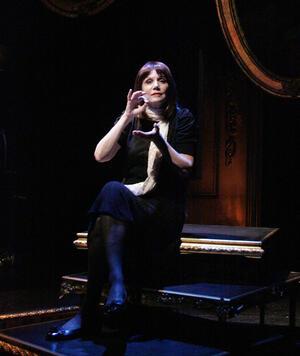Making Family Stories into Art
This weekend I was lucky enough to see two talented Jewish women make memorable art from their family stories. On Friday night, I went to Club Passim, the legendary folk venue in Harvard Square, to hear one of my favorite singer-songwriters, Lucy Kaplansky. Her set mixed old favorites with songs from her new CD, “Reunion.” The title track tells the story of two family reunions. The first in 1971, when she was 11, began at her grandmother’s bakery and continued at a fancy restaurant. The second “40 years on,” moved her to write “Here we are together/our fathers gone/ just daughters and sons.”
You can listen to this song on YouTube.
Her father, Irving Kaplansky, was the youngest of four sons; he was born in Toronto in 1917, shortly after his parents emigrated from Poland. The small bakery started by his enterprising mother became a successful Canadian chain. Unlike his three older brothers, he left Toronto after college. He completed a PhD in mathematics at Harvard and went on to have a distinguished career at the University of Chicago and later at the Mathematical Sciences Research Institute in California.
The song explains that Lucy used to believe that her father “was the lucky one, the one who got away,” but at the reunions, she’s not so sure. In less than four minutes, this poignant song tells the story of three generations of a Jewish family—from a resourceful immigrant woman who built a business, to the three sons who ran that business and the one son, who left home and became a star in his field, to his folk musician daughter.
The next day, as the season’s first snow fell, I took the subway downtown, braving slush and shoppers, to see “The Pianist of Willesden Lane,” show starring Mona Golabek.
For the next 90 minutes, I completely forgot about the world outside. I was transported first to Vienna in the late 1930s and then to London during the Blitz, as Mona Golabek combined dramatic storytelling and beautiful piano playing to trace the journey of her mother, Lisa Jura (a journey she recounts in her book, The Children of Willesden Lane).
A talented young musician, the teenage Lisa was put her on a Kindertransport to London, where she found safety among strangers. As the reviewer for The Boston Globe put it, this is a “tale Golabek has to tell—and we do sense that she has to tell it… It’s as if she is leafing through a family album, summoning memories, sharing confidences, showing us the pictures, and explaining why so many pages are empty.”
One of the most affecting pictures she evokes is of her grandmother, herself a concert pianist, bidding 14-year-old Lisa farewell at the train station. “Hold on to your music. It will be your best friend,” she tells the daughter she would never see again. Lisa Jura did manage to hold onto her music, while working in a garment factory, spending nights in an underground bomb shelter, attending the Royal Academy of Music on scholarship, playing in a hotel bar. She held onto it when she immigrated to America, teaching both of her daughters to become accomplished pianists. To share her mother’s story and use it to demonstrate the power of the arts, especially music, “to embolden the human spirit in the face of adversity,” Mona Golabek founded the Hold On To Your Music Foundation.
Lucy Kaplansky and Mona Golabek are lucky. As artists, they can turn their family stories into works of art that remind us how heartbreaking history can be.







wow!! nice art, music has always been such a thing that can cater emotions in a better way. I appreciate the talent and expect more things coming out!
<ul class="field"><li class="field-label-inline">If you'd like to bet on the net then this online pokies offers a lot of the right wager games that you've got been hunting for.</li> </ul>